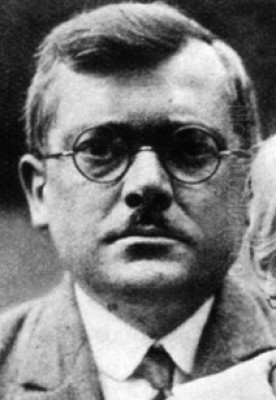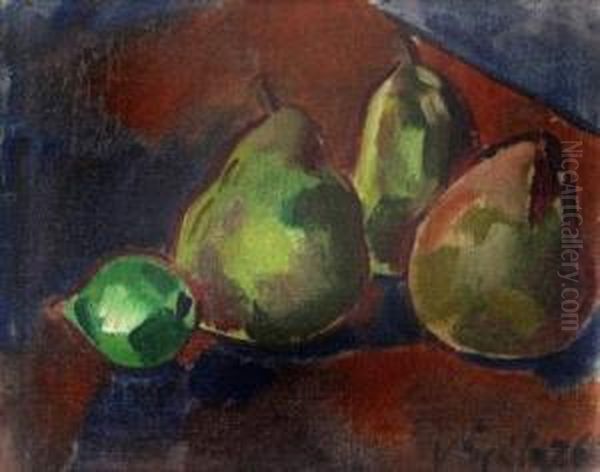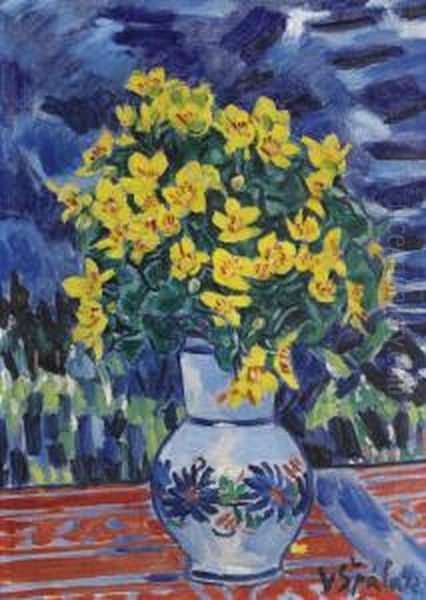
Václav Špála stands as one of the most significant figures in the landscape of 20th-century Czech art. Born in 1885 and passing away in 1946, his career spanned a period of intense artistic innovation and societal change in Europe. Primarily known as a painter and illustrator, Špála played a crucial role in navigating and shaping the course of modernism within his homeland, absorbing international influences while forging a distinctly personal and influential style. His journey through Expressionism, Fauvism, and Cubism resulted in a body of work celebrated for its vibrant color, emotional depth, and connection to Czech life and landscape.
From his early academic training to his mature, color-drenched canvases, Špála consistently engaged with the foremost artistic currents of his time. He was not merely a follower of trends but an active participant and innovator, particularly within the dynamic Czech avant-garde movements of the early 1900s. His legacy endures not only through his captivating paintings, held in major collections like the National Gallery Prague, but also through the continued relevance of his artistic vision and the gallery bearing his name in Prague.
Early Life and Artistic Formation
Václav Špála was born on August 24, 1885, in the small village of Žlunice, located in the Hradec Králové Region of what is now the Czech Republic. His origins in the countryside would later inform the subject matter of many of his works, revealing a deep connection to the rhythms and textures of rural life. Seeking formal artistic training, Špála moved to Prague, the vibrant cultural heart of Bohemia.
He enrolled at the prestigious Academy of Fine Arts in Prague, immersing himself in the academic traditions that still held sway at the turn of the century. However, Prague was also a crucible for new ideas filtering in from Paris and other European art centers. While initially identified as an "academic painter," Špála was keenly aware of the modernist revolutions unfolding across the continent. His education provided him with technical grounding, but his artistic spirit soon gravitated towards more expressive and experimental forms.

The artistic environment in Prague during Špála's formative years was rich and complex. Artists were grappling with the legacy of 19th-century realism and Impressionism while simultaneously encountering the radical departures of Post-Impressionism, Symbolism, and the burgeoning Fauvist and Expressionist movements. Figures like Edvard Munch had already demonstrated the power of subjective emotion in art, while the bold colors of Paul Gauguin and the structural innovations of Paul Cézanne were reshaping artistic possibilities. This dynamic atmosphere provided fertile ground for a young artist like Špála to find his voice.
Embracing Modernism: Fauvism and Expressionism
Špála's early professional work quickly showed a departure from strict academicism. He became deeply influenced by French modern art, particularly the Fauvist movement that had exploded onto the Paris scene around 1905. The Fauves, including artists like Henri Matisse and André Derain, championed the use of intense, non-naturalistic color and bold brushwork to convey emotional intensity rather than objective reality. This resonated strongly with Špála.
His paintings from the period between roughly 1907 and 1910 clearly demonstrate this Fauvist and Expressionist leaning. Works such as Country Girl (1907) and his Self-Portrait with Palette (1908) showcase a newfound freedom in his application of paint and a heightened chromatic palette. He wasn't simply imitating the French; he was adapting these principles to his own temperament and subjects, often infusing them with a specific Czech sensibility.
During this time, Špála was also connected with, or at least significantly influenced by, the activities of the Osma (The Eight) group. Founded in 1907, Osma was a crucial early association of Czech avant-garde artists who embraced Expressionism, drawing inspiration from Munch as well as the Fauves. Though Špála's direct membership status might be debated, the exhibitions and spirit of Osma undoubtedly impacted his development, pushing him further towards a modern, expressive style alongside contemporaries like Emil Filla and Bohumil Kubišta, who were central to the group. Another key figure emerging in this milieu was Jan Zrzavý, whose unique, lyrical modernism also took root during this period of intense artistic ferment.
Joining the Avant-Garde: Artistic Groups
As Špála's artistic identity solidified, he became an active participant in Prague's burgeoning avant-garde organizations. In 1909, he joined the Mánes Union of Fine Arts (Spolek výtvarných umělců Mánes), a prominent and long-standing society that, despite its established nature, became a crucial platform for modernist discourse and exhibitions in the early 20th century. Membership provided Špála with opportunities to exhibit alongside leading Czech artists and engage with contemporary artistic debates.

More significantly, Špála became a key member of the Skupina výtvarných umělců (Group of Fine Artists), often referred to simply as Skupina. Founded in 1911, this group represented a more radical break, specifically focused on absorbing and developing the principles of French Cubism and integrating them into a Czech context. Špála joined Skupina shortly after its inception and worked closely with figures like the brothers Josef Čapek and Karel Čapek (the latter primarily a writer but deeply involved in the artistic circle), Emil Filla, Antonín Procházka, and the sculptor Otto Gutfreund.
Špála's involvement with Skupina was pivotal. The group organized groundbreaking exhibitions, published journals (like Umělecký měsíčník or Art Monthly), and actively sought to define a unique Czech modernism. While there were internal shifts – Špála reportedly distanced himself somewhat from the Čapek brothers' specific direction around 1912 but remained with the broader group until about 1920 – his participation placed him at the very center of the Czech avant-garde's most dynamic phase. He was instrumental in the collective effort to introduce Cubism to Prague.
The Czech Cubist Adventure
Around 1913, Špála fully embraced Cubism, marking a significant shift in his style. However, Czech Cubism, while deeply indebted to the innovations of Parisian pioneers Pablo Picasso and Georges Braque, developed its own distinct characteristics. It often retained a greater degree of emotional expressiveness and dynamism compared to the more analytical approach of French Cubism, sometimes blending Cubist fragmentation with lingering Expressionist or Fauvist color sensibilities. This unique fusion is sometimes termed Cubo-Expressionism.
Špála's Cubist works exemplify this Czech adaptation. He adopted the geometric faceting and multiple viewpoints characteristic of the style, deconstructing forms and exploring the underlying structure of objects and figures. Yet, he rarely abandoned color as a primary expressive tool. His Cubist paintings often feature vibrant, contrasting hues that animate the fragmented planes, creating a sense of energy and rhythm. He applied this approach to various subjects, including landscapes, still lifes, and figurative compositions.
The peak of Czech Cubism as an organized movement was relatively short-lived, flourishing intensely between approximately 1911/1913 and 1915/1917, disrupted partly by the outbreak of World War I. Despite its brevity, this period was incredibly fertile, producing not only paintings and sculptures but also unique examples of Cubist architecture and design found nowhere else in the world. Špála was a central figure in this artistic explosion, contributing significantly to its visual language and helping to establish Prague as a major, albeit distinct, center of Cubist experimentation outside of Paris.
Developing a Unique Voice: Color and Subject
Even as he moved beyond the strictest phase of Cubism after World War I, the lessons learned during that period continued to inform Špála's art. He developed an increasingly personal style characterized by a synthesis of structural simplification derived from Cubism and an intense, often symbolic, use of color rooted in his earlier Fauvist explorations. Color became perhaps the most defining element of his mature work.
Špála became particularly renowned for his distinctive use of blues and reds, often employing them in bold, contrasting combinations. His landscapes, frequently depicting the Czech countryside he knew intimately, such as the areas around the Sázava River, were transformed through his subjective chromatic lens. Works like Bouquet by the Sázava River are celebrated examples of his ability to capture the essence of a place through vibrant color and simplified forms, achieving a lyrical and decorative quality.
Still life also became a major genre for Špála, allowing him to explore form and color relationships with focused intensity. He repeatedly painted arrangements of flowers, fruits, and simple objects. Bananas, Apples and Wine (1927) showcases his ability to blend Czech and French sensibilities, perhaps echoing Impressionist concerns with light and color but filtered through a modern, structured approach. Pink and Yellow Azaleas on a Polka Dot Fish Blanket (1939) demonstrates his later mastery of complex compositions and rich, decorative surfaces. His treatment of these familiar subjects was always fresh and visually arresting.
Beyond landscapes and still lifes, Špála continued to engage with the human figure and aspects of daily life. His famous painting Three Washerwomen, housed in the National Gallery Prague, depicts rural labor with a sense of monumentality and empathy, rendered in his characteristic bold style. Another work, Waiting (1918), has been interpreted as reflecting a sensitivity to the conditions of urban life and the working class, demonstrating that his art, while often celebratory in its use of color, was not detached from social realities. Other notable works include Eve (1911), Two Swans (1922), Lidovky (1921), Puddles in a Pitcher, and Still Life with Pears.
Later Career and Academic Role
In the 1920s, Špála's position within the Czech art establishment was solidified. He was appointed as a professor at the Academy of Fine Arts in Prague, the same institution where he had studied. This role allowed him to influence a new generation of Czech artists, passing on his experience and insights gained through years at the forefront of the avant-garde. His teaching career coincided with a period of relative stability and cultural flourishing in the newly formed Czechoslovak Republic.
Throughout the 1920s and 1930s, Špála continued to paint prolifically, refining his signature style. While the radical experimentation of his Cubist phase subsided, his commitment to expressive color and simplified form remained constant. His works from this period often exhibit a sense of harmony and balance, though still charged with chromatic energy. The prevalence of blue tones, particularly in his landscapes and still lifes of the 1930s, became a hallmark, leading some critics to refer to a "blue period" in his later work, distinct from Picasso's earlier phase of the same name.
He remained an active exhibitor and a respected figure in the art community. His work was seen as representing a modern yet accessible and distinctly Czech artistic voice. He successfully navigated the transition from the pre-war avant-garde to the established art scene of the interwar republic, maintaining his artistic integrity while achieving widespread recognition.
Context and Connections: Contemporaries
Václav Špála did not work in isolation. His career unfolded within a vibrant network of artistic relationships, collaborations, and sometimes, implicit rivalries. His close association with key figures of the Skupina group, such as the painter and writer Josef Čapek and the painter Emil Filla, was crucial in the early, formative years of Czech Cubism. They shared a common goal of forging a modern Czech art, engaging in intense dialogue and collective exhibition efforts.
His collaborative spirit extended to other areas as well. Špála contributed to the burgeoning field of Czech poster art, working alongside artists like the aforementioned Jan Zrzavý and Josef Lada, the latter famous for his charming illustrations, particularly for The Good Soldier Švejk. This involvement highlights the interconnectedness of fine art and graphic design within the Czech modern movement.
However, Špála's path can also be contrasted with other prominent Czech artists of the era. Alphonse Mucha, for instance, represents a different facet of Czech modern art. While internationally famous for his Art Nouveau posters, Mucha later dedicated himself to the monumental Slav Epic, a cycle of paintings celebrating Slavic history and mythology. Mucha's work, with its emphasis on national identity, historical narrative, and decorative symbolism, stands in stark contrast to Špála's more formalist concerns, his engagement with international styles like Fauvism and Cubism, and his focus on contemporary life, landscape, and still life through a highly personalized lens of color and form. This comparison underscores the diversity of artistic expression within Czech modernism.
Spotlight on Key Works
Several works stand out as particularly representative of Václav Špála's artistic achievements and stylistic evolution. Three Washerwomen, likely painted in the early 1910s, exemplifies his engagement with themes of rural labor, treated with a modern sensibility. The figures are rendered with bold outlines and simplified forms, their bodies solid and monumental. The colors, while perhaps not as strident as in his peak Fauvist phase, are strong and expressive, contributing to the work's powerful, earthy quality. It reflects both his connection to Czech rural life and his absorption of modern stylistic devices.
Bouquet by the Sázava River, from his mature period, showcases his mastery of landscape and color. The Sázava River valley was a recurring motif for Špála. In this work, the landscape elements – water, trees, perhaps distant hills – are simplified into rhythmic patterns of color and form. The bouquet in the foreground provides a focal point of intense chromatic richness. The painting radiates a sense of joy and harmony, achieved through Špála's signature palette, likely featuring his characteristic vibrant blues and contrasting warm tones. It embodies his lyrical response to nature.
Bananas, Apples and Wine (1927) represents his later still life practice. The composition is carefully structured, showing the enduring influence of Cubist principles in its organization of forms and space. However, the emphasis is on the sensuous qualities of color and light. The fruits and objects are rendered with a palpable presence, their rounded forms contrasting with the angularity of the background elements. The work demonstrates the successful fusion Špála achieved between French modernist influences (perhaps recalling Cézanne's still lifes in its structural solidity) and his own innate Czech feeling for color and subject matter.
Enduring Legacy
Václav Špála passed away in Prague on May 13, 1946, shortly after the end of World War II. He left behind a substantial body of work and a significant imprint on the history of Czech art. His contributions were recognized during his lifetime, and his reputation has endured. His paintings are prized possessions of the National Gallery Prague and other major Czech collections, as well as appearing in private collections and international auctions. The continued market interest in his work, evidenced by appearances in sales like the Expo 58 themed auction in 2024 and the Prague Evening Sale featuring works like Puddles in a Pitcher and Still Life with Pears, attests to his lasting appeal.
Perhaps the most visible testament to his enduring importance is the Václav Špála Gallery (Galerie Václava Špály) located on Národní třída in the heart of Prague. Established in 1957, this independent gallery, while not exclusively dedicated to showing Špála's work, bears his name in honor of his contribution to Czech modernism. Over the decades, it has gained a reputation for presenting significant, sometimes controversial, exhibitions of both Czech and international contemporary art, including historically important shows featuring artists like Marcel Duchamp, thus continuing Špála's legacy of engaging with the forefront of artistic practice.
Špála's influence extends beyond specific works or institutions. He played a vital role in acclimatizing Czech culture to modern European art movements, demonstrating that international styles could be adopted and transformed to express a unique national sensibility. His unwavering commitment to color as an expressive force and his ability to find profound beauty in everyday subjects continue to inspire artists and resonate with audiences today.
Conclusion
Václav Špála's artistic journey charts a course through the heart of European modernism, yet remains deeply rooted in his Czech identity. From his early embrace of the revolutionary colors of Fauvism and Expressionism, through his pivotal role in the Czech Cubist movement alongside contemporaries like Filla and Čapek, to the development of his unique mature style characterized by vibrant hues and simplified forms, Špála consistently forged a path of innovation and personal expression.
His paintings, whether depicting the rolling landscapes of Bohemia, intimate still lifes, or scenes of rural life, are imbued with an unmistakable energy and a profound feeling for color. He successfully synthesized international avant-garde principles with local traditions and personal vision, creating a body of work that is both historically significant and visually captivating. As a painter, illustrator, and influential teacher, Václav Špála remains a cornerstone figure in Czech modern art, whose legacy continues to be celebrated and explored.